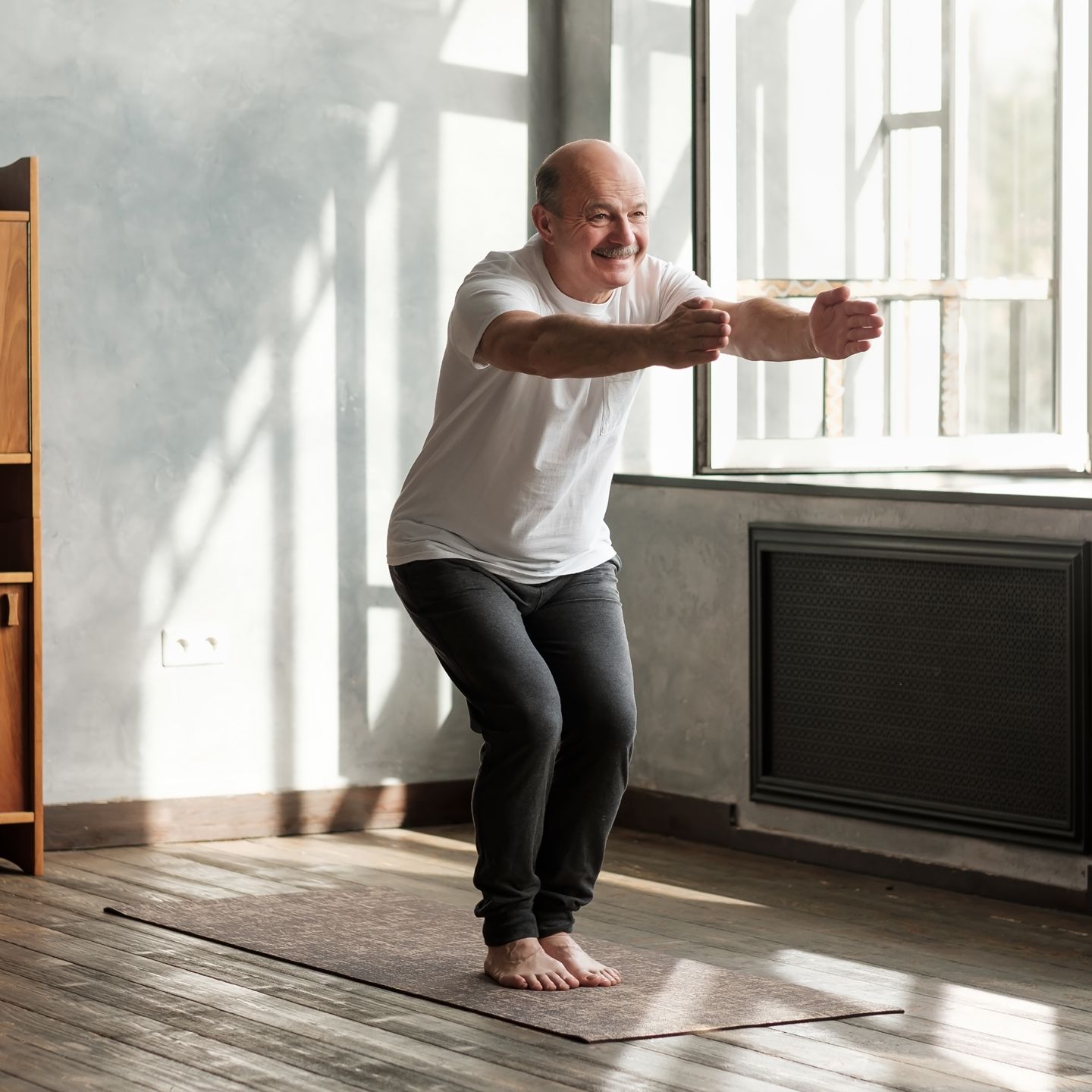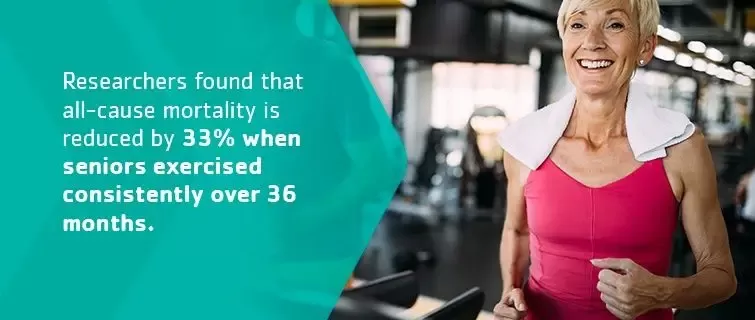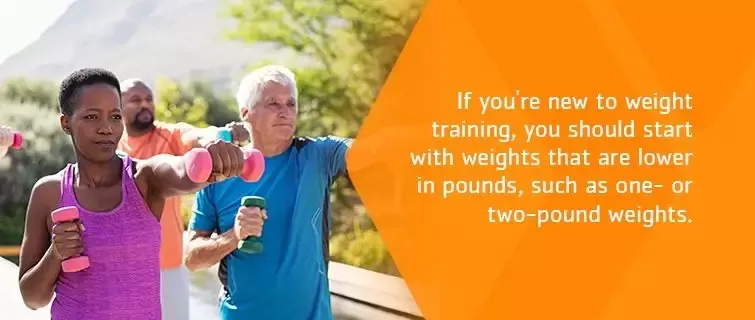
As you get older, it's natural to slow down, but that doesn't mean you can't stay active. Continuing to exercise is one of the best gifts you can give your mind and your body. By staying active, you'll reduce your risk for several diseases while also keeping your mind sharp and your body feeling great. Though exercise can feel daunting, especially if you're used to a more sedentary lifestyle, it can bring a lot of value and joy to your life once you begin doing it. Whether you want to exercise by yourself or do it in a group, there are plenty of options available. As you consider making exercise a priority, you'll need need to know how to stay fit, the best exercises to do and the benefits that come as a result of exercising regularly.
Importance of Exercise for Seniors
Exercise helps to reduce seniors' risks for a variety of physical and mental illnesses. To give you a taste of just how important exercising is to your long term health and wellness, consider some of the key factors below:
- Reduce heart disease: One of the leading causes of death in the United States is heart disease. According to the Centers for Disease Control and Prevention (CDC), one out of four deaths is caused by heart disease. Exercising helps to prevent heart disease from ever becoming a problem. Living an active lifestyle helps to decrease LDL cholesterol, as well as keeps blood glucose and blood pressure at appropriate levels.
- Manage arthritis: Arthritis is a common ailment among seniors. Instead of having to take pain relievers every day, you can manage arthritis by exercising, which acts as a sort of lubricant for your joints. By keeping your joints moving regularly, you'll avoid the stiffness and pain that comes with arthritis. Additionally, exercise reduces the chance of obesity, which can exacerbate the effects of arthritis.
- Combat depression: Depression is a mental illness that affects people of all ages, but it can be especially harmful to seniors who live a sedentary lifestyle. Exercising is known to improve mood and reduce symptoms caused by depression. Researchers found that older adults can reduce the symptoms of depression by over 30% by exercising regularly.
- Prevent diabetes: Type II diabetes is a result of the body being in metabolic dysfunction. Exercise is crucial to prevent type II diabetes or to help manage it if you already have it. Exercising regulates your insulin and blood glucose level, which in turn reduces the chance that you get type II diabetes.
- Decrease the risk of dementia: Dementia affects over 50 million people worldwide, and there isn't a cure. With the disease most commonly affecting seniors, it's important to do as much as you can to prevent it. One means of prevention is through aerobic exercise. Staying fit can make a major difference in reducing the chances of Alzheimer's and dementia as a whole.
- Minimize all-cause mortality: Exercise helps to prevent deaths from all causes. Researchers found that all-cause mortality is reduced by 33% when seniors exercised consistently over 36 months. This finding means that by staying active, seniors can prevent premature death from a variety of causes.
Exercises for Older Adults
If you're looking for exercise ideas for seniors, you'll need to incorporate a mixture of strength training and aerobic activities into your exercise regimen. Additionally, balance and flexibility are key factors to staying comfortable and going about all of the daily tasks you regularly do. Below, you can find an overview of the main exercises for older adults:
1. Balance
According to the CDC, 3 million American senior citizens are treated in emergency departments every year due to injuries sustained by falling. As you get older, a fall can cause greater damage, so it's important to incorporate exercises that help you maintain your coordination and not be susceptible to falls. One popular option for fitness for those over 50 is yoga. Many yoga studios and gyms offer yoga classes specifically for those who are older. In a yoga class, you'll meet other people and have an instructor take you through several exercises that help people stay balanced. For those who want to work on their balance on their own, toe stands and heel-toe walks are excellent places to start. In a heel-toe walk, you'll pretend that you're walking on a tightrope as you put one foot in front of the other, with your heel and front toe touching at the end of every step. A toe stand will simply require you to stand behind a chair, for stabilization, and lift your body off the ground as high as possible with your toes. Once you're more comfortable, you can stop holding the chair for balance and simply do it by yourself.
2. Flexibility
If you've started to notice that it's getting more difficult to bend over to grab an item off the floor or extend your arms high enough to reach something in a cabinet, it's important you begin exercises that maintain your flexibility. After all, you probably want day-to-day tasks like getting dressed or standing after sitting to stay pain-free. One of the best ways to keep your range of motion high is through stretching. When you stretch, it's important that you begin by warming up through walking or marching in place for three to five minutes. Once the warmup is complete, you'll begin your stretching. Don't try to speed through it. Instead, move into each stretch in the proper form and then hold the stretch for 10 seconds, if not more. Another important aspect of stretching is to breathe throughout your stretch. While stretching can be done on its own, some stretching is perfect to do after you're done exercising. You'll also notice that if you go to a yoga class, you'll be stretching a lot, meaning that these classes can help your balance as well as your flexibility. If you notice that a stretch is painful, you'll need to adjust how you're stretching. A stretch should never make you feel major pain, and if you do experience it during a stretch, you should ease up and not push yourself too hard. While a good stretch will make you feel some mild tension and discomfort, it should never rise to the point of being painful. If you're feeling pain, you should stop immediately, as continuing to stretch could cause injury.
3. Strength Training for Seniors
Any exercise plans should include weight training for seniors. Building your muscle strength is crucial to maintaining a high quality of life. Many seniors find strength training to be a fun way to exercise. The challenge that comes from trying to lift more weight and better yourself makes it one of the most rewarding exercises, especially for those who like to compete against themselves. Strength training is specifically used by people to build muscle through repetitive motions. These motions will feature weight or other kinds of external resistance from machines, free weights, elastic bands and body weight. To improve your reaction time and muscle strength, you can incorporate power training into your workout, which is basically just strength training done faster. If you're new to weight training, you should start with weights that are lower in pounds, such as one- or two-pound weights. As you get used to lifting them with the proper form, and without any difficulty, you can begin to increase the weight. Lifting will produce some minor soreness, but that's actually a good sign, as it indicates your muscles are growing stronger. You'll want to do weight training for 30 minutes twice a week, along with making sure you exercise the major muscle groups. Some popular strength training exercises include overhead press, hip extensions, curl-ups and side leg raises. It's often a good idea to work with a trainer or take a class at the beginning to help you lift with the proper form and develop a workout plan that meets your goals. Strength training is well known for its benefits. People who strength train have more muscle and reduce the loss of bone mass. With greater strength, seniors regularly maintain their independence longer and improve their ability to go about daily tasks. With strength training, you won't have trouble getting out of your car, lifting items around the house or opening a jar.
4. Cardio
Cardio shouldn't be ignored, as it helps to improve endurance and reduce fatigue. The CDC recommends that those who are 65 years or older get 150 minutes of exercise at a moderate-intensity aerobic level or 75 minutes of exercise at a vigorous-intensity level every week. When you engage in these exercises, you'll be using your large muscle groups in rhythmic motions for an extended period. The heart becomes deconditioned and weaker the fewer demands your body makes on it. If you live a sedentary lifestyle, your heart will naturally weaken, as you will be relying on it less in your day-to-day life. This lack of use opens people up to diseases that affect the heart and makes it more difficult for them to go about daily tasks without discomfort, but these negative effects can be turned around by exercising regularly. Typical cardio exercises include walking, hiking, tennis, dancing, cycling, stair climbing and rowing. These cardio exercises raise your heart rate and improve lung functioning. Walking is one of the most well-regarded types of cardiovascular exercise as it helps to maintain your bone strength as well as raising your heartbeat. By engaging in cardio regularly, you should notice that you don't have as many periods where you're feeling short of breath or fatigued. Additionally, cardio is a way to ensure that you maintain your independence over the years. For example, having the stamina to walk your neighborhood will also give you the endurance to go out on errands and keep the house tidy. Another great aspect of cardio is that it can also be a way to remain social. Having someone to walk or go on bike rides with regularly can make the time fly by, improving both your mood and your body's health.
Benefits of Senior Citizen Fitness
By following the exercises listed above, you'll reap several benefits that improve your quality of life and reduce the chances of getting a variety of illnesses. To give you that extra push to go out and exercise, consider the following advantages that exercising brings:
- Greater flexibility and mobility: When you exercise, you'll begin to notices changes in how strong you feel and how flexible you are. Proper exercising also helps your posture. As a result of greater flexibility and strength, you'll maintain a greater equilibrium with improved coordination and balance. Exercising helps you reduce your chance of falling and minimizes the risk that comes with falling down.
- Stay in shape and lose weight: It's proven that as people grow older, their metabolisms slow down. Though the metabolism slowing is natural, it's something you have to watch out for, as it makes it more difficult to lose weight and maintain your current weight. Staying active will help you combat a slower metabolism, as you burn calories while you exercise.
- Reduces the chances of chronic disease and illness: Seniors who exercise will typically have a higher bone density, better blood pressure, a stronger immune system and improved digestive functioning when compared to those who don't. Thanks to these improvements, those who exercise also have a lower risk of certain cancers, heart disease, Alzheimer's disease, osteoporosis, obesity and diabetes.
- Better mood: Exercise helps people feel like they're on top of the world. The endorphins produced by exercising reduces stress a great deal. If you've noticed you've felt more depressed, anxious or sad lately, you should try exercising to help combat those feelings and feel more confident in yourself.
- Improved brain functioning: When you exercise, you're helping your mind as well as your body. There's a wealth of information that shows exercise prevents cognitive decline, dementia and memory. Additionally, staying active helps your brain improve its creative and multitasking ability. If you want to stay as sharp as possible as you age, exercising is one of the most important factors.
- Get enough sleep: Along with exercising, sleep is critical to long-term health. When you regularly exercise, you should find that you fall asleep faster, rest throughout the night and wake up feeling ready to take on the day. The logic behind it is that by being active throughout the day, you'll be more tired at the end of it, making it easier to fall asleep.


